The Bulldozer Review: AMD FX-8150 Tested
by Anand Lal Shimpi on October 12, 2011 1:27 AM ESTGaming Performance
AMD clearly states in its reviewer's guide that CPU bound gaming performance isn't going to be a strong point of the FX architecture, likely due to its poor single threaded performance. However it is useful to look at both CPU and GPU bound scenarios to paint an accurate picture of how well a CPU handles game workloads, as well as what sort of performance you can expect in present day titles.
Civilization V
Civ V's lateGameView benchmark presents us with two separate scores: average frame rate for the entire test as well as a no-render score that only looks at CPU performance.
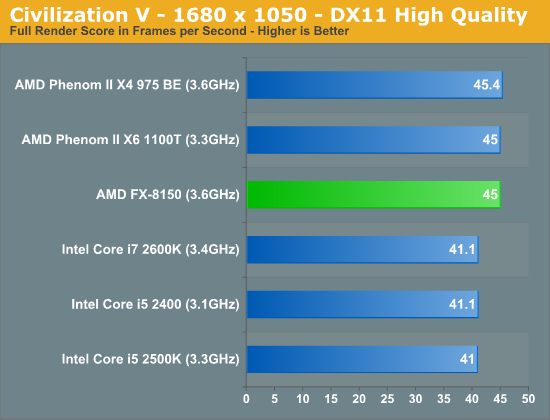
While we're GPU bound in the full render score, AMD's platform appears to have a bit of an advantage here. We've seen this in the past where one platform will hold an advantage over another in a GPU bound scenario and it's always tough to explain. Within each family however there is no advantage to a faster CPU, everything is just GPU bound.
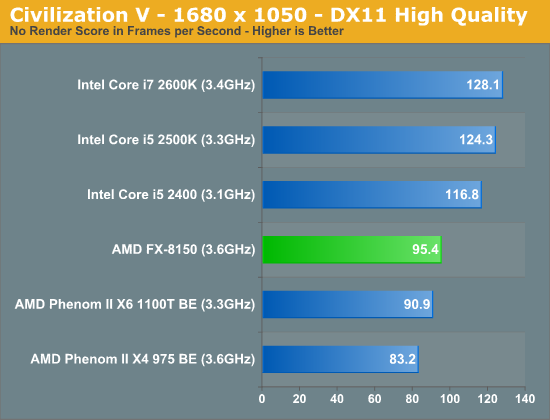
Looking at the no render score, the CPU standings are pretty much as we'd expect. The FX-8150 is thankfully a bit faster than its predecessors, but it still falls behind Sandy Bridge.
Crysis: Warhead
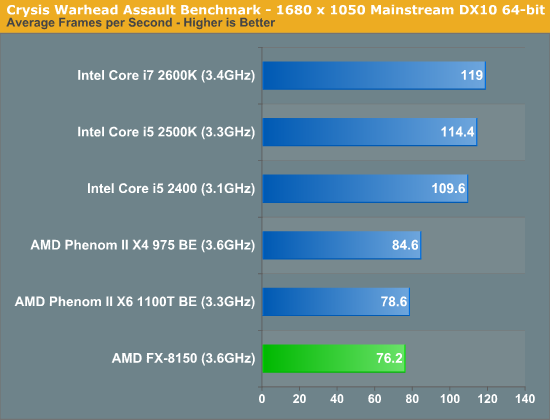
In CPU bound environments in Crysis Warhead, the FX-8150 is actually slower than the old Phenom II. Sandy Bridge continues to be far ahead.
Dawn of War II
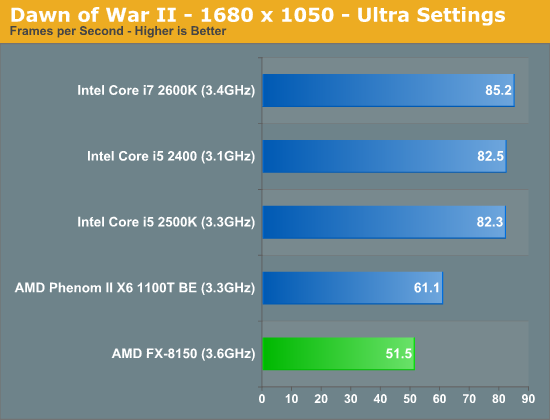
We see similar results under Dawn of War II. Lightly threaded performance is simply not a strength of AMD's FX series, and as a result even the old Phenom II X6 pulls ahead.
DiRT 3
We ran two DiRT 3 benchmarks to get an idea for CPU bound and GPU bound performance. First the CPU bound settings:
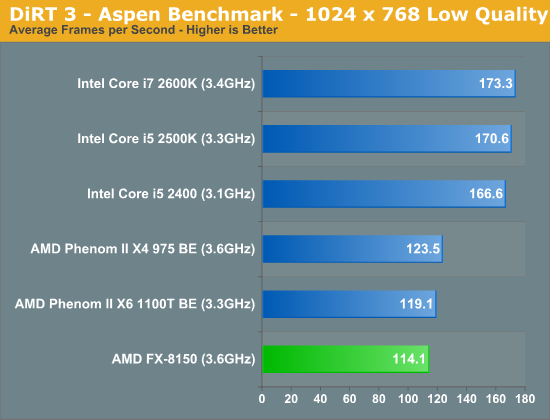
The FX-8150 doesn't do so well here, again falling behind the Phenom IIs. Under more real world GPU bound settings however, Bulldozer looks just fine:
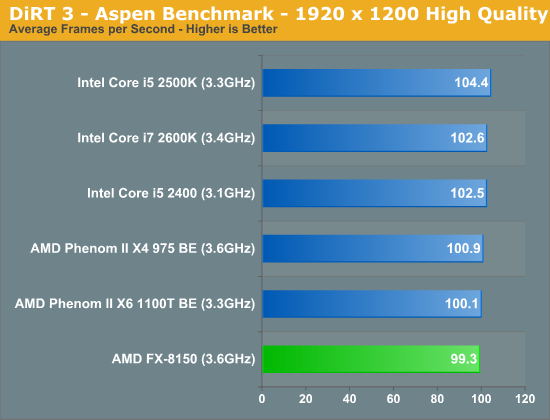
Dragon Age
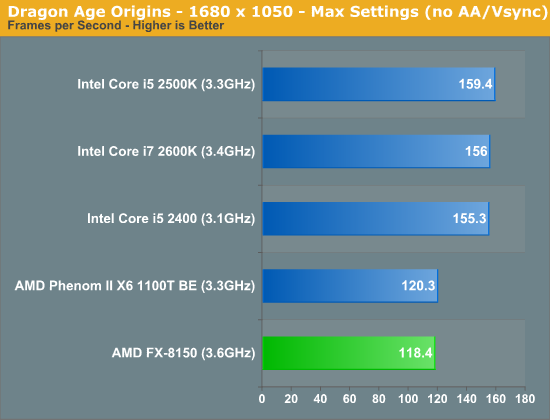
Dragon Age is another CPU bound title, here the FX-8150 falls behind once again.
Metro 2033
Metro 2033 is pretty rough even at lower resolutions, but with more of a GPU bottleneck the FX-8150 equals the performance of the 2500K:
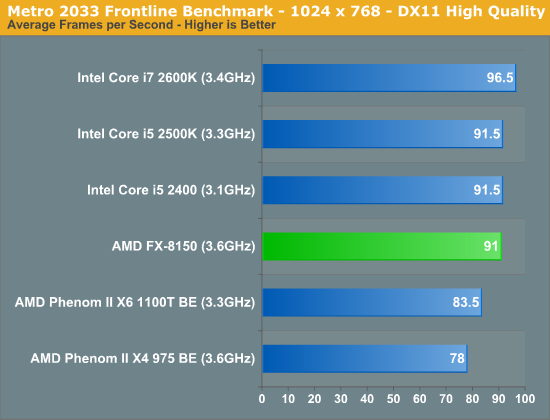
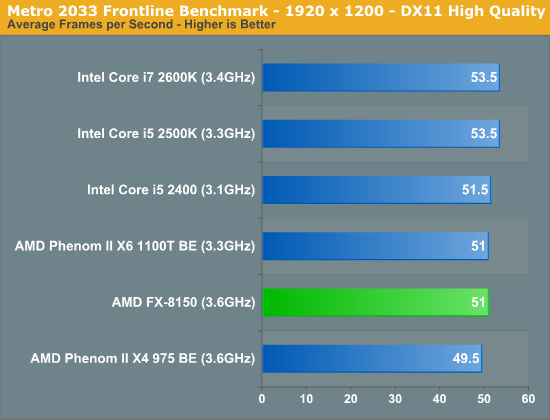
Rage vt_benchmark
While id's long awaited Rage title doesn't exactly have the best benchmarking abilities, there is one unique aspect of the game that we can test: Megatexture. Megatexture works by dynamically taking texture data from disk and constructing texture tiles for the engine to use, a major component for allowing id's developers to uniquely texture the game world. However because of the heavy use of unique textures (id says the original game assets are over 1TB), id needed to get creative on compressing the game's textures to make them fit within the roughly 20GB the game was allotted.
The result is that Rage doesn't store textures in a GPU-usable format such as DXTC/S3TC, instead storing them in an even more compressed format (JPEG XR) as S3TC maxes out at a 6:1 compression ratio. As a consequence whenever you load a texture, Rage needs to transcode the texture from its storage codec to S3TC on the fly. This is a constant process throughout the entire game and this transcoding is a significant burden on the CPU.
The Benchmark: vt_benchmark flushes the transcoded texture cache and then times how long it takes to transcode all the textures needed for the current scene, from 1 thread to X threads. Thus when you run vt_benchmark 8, for example, it will benchmark from 1 to 8 threads (the default appears to depend on the CPU you have). Since transcoding is done by the CPU this is a pure CPU benchmark. I present the best case transcode time at the maximum number of concurrent threads each CPU can handle:
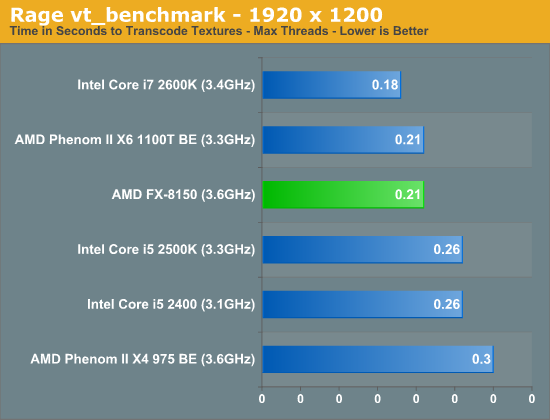
The FX-8150 does very well here, but so does the Phenom II X6 1100T. Both are faster than Intel's 2500K, but not quite as good as the 2600K. If you want to see how performance scales with thread count, check out the chart below:
Starcraft 2

Starcraft 2 has traditionally done very well on Intel architectures and Bulldozer is no exception to that rule.
World of Warcraft
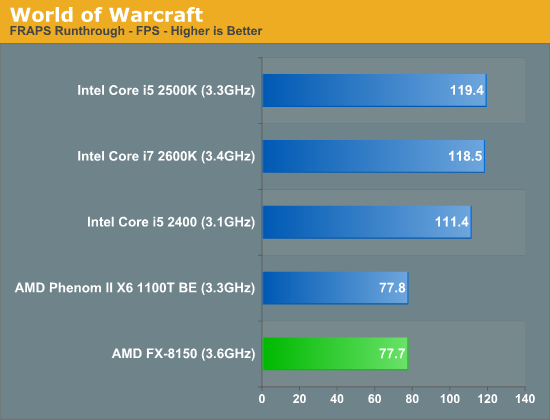


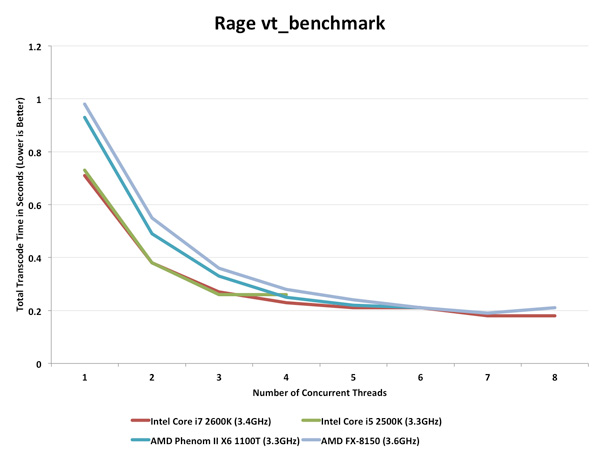








430 Comments
View All Comments
silverblue - Friday, October 14, 2011 - link
We don't know the server performance yet. There's also some frantic investigations going on into why the client benchmarks were so poor, so watch this space.IceDread - Friday, October 14, 2011 - link
I always observe. I hope AMD makes a comeback because the market needs competition to work in favor of the customer.Analytics believes Amd is becoming irrelevant on the processor market, which is really bad. They believe AMDs share is worth 4 dollar each now and not five dollar which they believed before.
I do not know if new drivers would help Amd out or not but 10% more or less does not cut it. I really hope Amd makes a comeback with a new cpu in a couple of years but only time will tell. How they could release this one is not understandable, they had to known the values.. something is not always better than nothing..
chrone - Wednesday, October 12, 2011 - link
even phenom ii x6 is way better. :(piroroadkill - Wednesday, October 12, 2011 - link
Because there is no longer anything to wait for. Bulldozer is an absolute failure. Oh dear.That's not helpful at all, because a competitive AMD CPU is just what the market needs right now.
MossySF - Wednesday, October 12, 2011 - link
The worse part about this review is the MB diagram. Earlier this year, the diagrams for the SB950 showed a 4GB/s Alink III Expression connection. The diagram in this review shows 2GB/s -- the same as the previous SB850 and competing Intel chipsets.Who cares about CPU speed ... they're all close enough. We need I/O speed way more. I have a new server with5 x 6Gbps Sandforce SSDs in a RAID0 array and we hit the 2GB/s limit with just 2 drives. (2GB/s bidirectional is 1GB/s each way.)
And no, I have zero confidence that any 4-port/8-port RAID controller has enough power either. Maybe the most expensive 24-port ones can do it but I am not going to continually buy and return $2000 controllers until I find one that is beefy enough. Especially since the majority of the RAID functionality is completely wasted with SSDs.
nexox - Wednesday, October 12, 2011 - link
OT, but you may want to try a SAS2 HBA based on the LSI 2008 chip - They're generally around $150 and I promise they can do:A) Far higher performance than any crappy motherboard controller.
B) Way more than 2GB/s full duplex.
If you're worried about storage performance while using an on-board disk controller, you're just going about it all wrong, especially if you think you're going to gain much using their crappy software raid.
gvaley - Wednesday, October 12, 2011 - link
This monster, in this particular test, adds over 144W going from idle to full load! (For comparison the i2600K adds mere 78W and performs a notch better.) Assuming it already wastes ~10W at idle and even by factoring in the increase in power usage coming from the chipset/memory, I still very much doubt it that this...hm..thing...can fit into the stated 125W TDP.Good thing Anand didn't do the performance per watt maths...it would've painted a devastating picture.
f4phantom2500 - Wednesday, October 12, 2011 - link
i think i'll hold on to my unlocked/overclocked phenom ii x3 for now.iwod - Wednesday, October 12, 2011 - link
Intel made most of their money with Server CPU. And If BD perform well there, then i suppose AMD still have some breathing space.Otherwise with Ivy Bridge, AMD doesn't have a single chance of surviving in the near future. Gfx are much better with Ivy, and with its video decoding engine that seems to be much better then even Nvidia or AMD.
milli - Wednesday, October 12, 2011 - link
"Sandy Bridge, which on Intel's 32nm HKMG process is only 1.16B transistors with a die size of 216mm2"But in the table below it you say it's 995M transistors.
In the AMD table, you mention '3MB' as NB Clock for the AMD Phenom II X6 1100T.